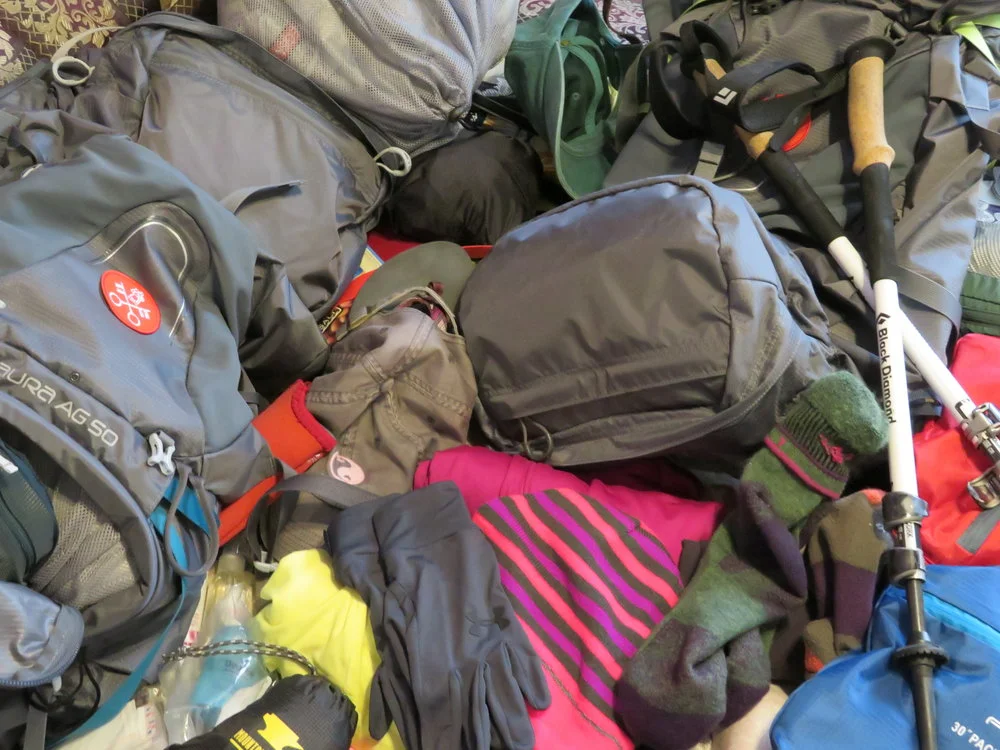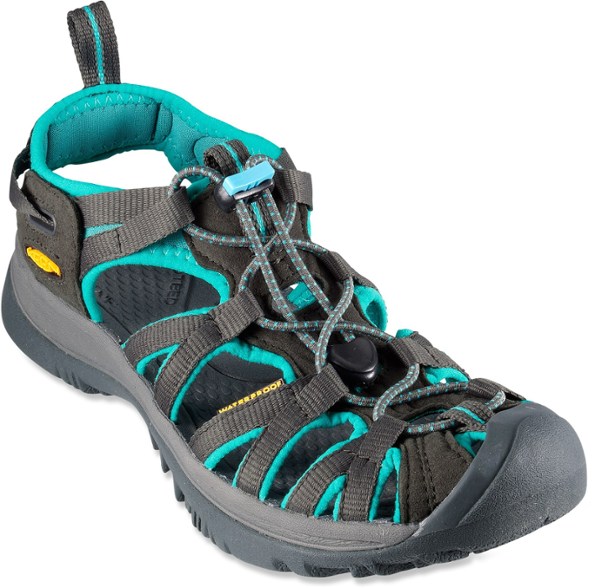Blue View – Gear List for the Via Francigena
/We took a lot of gear
We learned a great deal about our gear needs from our trek along the Thames last fall. This time around we did a better job selecting what to pack, but by the time we finished the Via Francigena, we still came up with a number of things we’ll do differently next time.
Synthetics. To begin, we invested in lightweight, synthetic clothing that not only weighs less, but packs well, never needs ironing, and perhaps most importantly, dries really quickly. We did a lot of hand washing of clothes – at least underwear, socks and base layers every day. These would get hung up to dry, and with only rare exceptions, were dry by the morning... unlike the predominantly cotton clothing we took for the Thames Path, which sometimes took days to dry. Marcie is a terrific thrift store shopper, and she was able to find much of our gear there. What we couldn’t find that way, I bought at a discount by waiting until the various online outfitters had sales or put things on clearance. The downside, albeit a small one, is that many times items are put on clearance because they are unusual colors that didn’t sell, and I have to admit, some of my color combinations won’t ever make the cover of GQ. (But then, I’m somewhat fashion challenged, and unless Marcie says something like “Ahh, hmmm, are you going to wear that shirt with those pants?”, I’d have no clue anyway.)
Trousers. I took two pairs of lightweight, quick drying trousers, while Marcie took one mid-weight pair and one lightweight pair. The only change here would be to make sure they were tight fitting when we left, because by the end, with our weight losses, they were very loose fitting. I wore the same pair, my Prana Zion khaki cargo pants, almost everyday for the entire 4 months, and they look almost as good as when we started. The second pair, the same style but in a charcoal color, were only worn when the first was being washed or when I wanted something just slightly more dressy. Marcie alternated between her Kuhl mid-weight and REI lightweight trousers depending on the weather.
Shirts. We both brought an REI Sahara shirt. These are vented, hot weather shirts that provide some cover from the sun, and we both like them. They served as another in-between layer when needed, were worn alone on a few scorching, sunny days, and were dressy enough to wear to dinner in the touristy areas.
Base layers. We both brought two short sleeved base tops (think synthetic t-shirts), all of which were found in thrift shops. There was rarely a day when we didn’t wear them, either as a base layer under other warmer layers, or as our only shirts when it was scorching. They held up amazingly well, but all were looking a bit pilled and worn by the end. They were quite easy to wash at the end of each day and dried in a matter of a couple hours.
I took two and Marcie had three long sleeved base layers which were our next layers, thinking we might need all of them if it was cold enough. We never had to wear them all, even in 30F (-1C) degree weather – in fact, we could have each done with one less. Once past the Alps, we shipped one each back home.
We each took a pair of base lowers (we used to call these long underwear) as well. We both only wore them a couple of times, then shipped them home.
Underwear. Marcie had the right formula on the Thames walk, while I switched from 6-7 pairs of cotton shorts to three microbial, quick dry shorts. On the Thames, I rationalized we’d do laundry once a week, and I’d carry enough changes to make it between washings. That didn’t work as planned and we found it’s much better switching to a clean pair at the end of the day, hopefully after a shower, then washing out the old pair and hanging them up to dry.
Micro-fleece top. We both have an Arc’teryx fleece top and like them. They are rugged, lightweight, quick drying, warm, and best of all, good looking. The only negative is that, even on sale, they’re damned expensive. We wore them almost daily until past the Alps, then occasionally on cool mornings and evenings through France and England, and they still look almost new. (BTW, Marcie’s first Arc’teryx was looking quite pilled after much less use than this trek, and REI happily exchanged it for a new one – which has done much better).
Our Injinji toe socks - weird but we love em
Socks. We’ve already devoted a lot of blog space extolling the virtues of our Darn Tough socks and Injinji toe socks. We both brought three pairs of each, and none are looking the least worn. These work for us and we won’t be changing a thing.
Hats. We both brought a wool hat for the Alps, which we only wore a few times. They were most welcome on those days, however, and worth bringing, especially since they didn’t weigh much or take up much space. Once past the Alps, they were donated to a local charity shop. Every other day, we wore ball caps. We thought we’d be able to buy floppy, large brim hats once we got to France, and there were a few days when they would have been welcome, but we never bothered.
Gloves. One pair apiece.
Hiking Shoes. Like socks, this is a subject I’ve already droned on about at length. To summarize, we both like Hoka One One Trail runners and we used 1-3/4 pairs apiece – the second pair are just about done. Their only downside in my mind is that we bought the breathable versions, and both of us were squishing in no time if we even walked through dewy grass. Marcie may rethink her decision, but so far I’d rather have wet feet than the smell my old waterproof shoes used to produce.
Marcie’s Keen Whisper Sandals were a tad too heavy
My Merrell Vapor Glove Four running shoes
Lightweight shoes. We both brought a second pair of shoes. Ideally these shoes would be comfortable on our weary feet as we explored each new town at the end of the day, could be used for river crossings to keep our regular shoes from getting wet, ditto as shower shoes, and wouldn’t weigh much or take up much room in our packs. Marcie was opting for her Freewater flipflops, but ended up taking a pair of Keen Whisper Sandals. These pretty much fit the bill, but weighed more than we hoped for. I took a pair of Merrell Vapor Glove Four running shoes. These also came close to the ideal, except that they looked like clown shoes on me and weren’t comfortable for walking any distance. We’ll both rethink this next time – maybe flipflops for both us?
Packs. We are still quite happy with our Osprey packs. Marcie's is the Osprey Aura, which has a capacity of 50 liters and weighs 4.1 pounds. Mine is the Osprey Atmos, which also has a capacity of 50 liters and weighs 4.2 pounds. They are very comfortable to wear and distribute the loads evenly between the shoulders and hips. If they ever wear out, Osprey has a line of highly rated, lighter weight packs that we may consider.
Rain gear. We endured more than a few long rainy days, especially in springtime Italy, and our rain gear got a workout. We have lightweight rain covers for the packs which actually kept our packs dry, weigh only ounces and pack away into their attached stuff sacks. We also have breathable, good quality rain pants, and lightweight rain jackets, all of which weigh very little and stow away in their own pockets. The jackets served as windbreakers over lots of layers in the cold weather of the Alps, yet weren’t oppressively hot on warm, rainy days in France. Marcie’s only complaint with her Mountain Hardware Ozonic jacket is that the pocket zippers kept getting caught . My only complaint with my Marmot PreCip rain jacket was the crinkly noise it made when I moved.
Nice looking, but the zippers on Marcie’s rain jacket kept getting caught
Travel Gear. We checked our packs as baggage, and in the hope of preventing them from getting damaged, we bought two, very lightweight duffles to protect them enroute. Once off the plane, the duffles fold up into quite small packages that we stowed in the packs. For a carry-on bag, we found a 20L day pack that weighs only a few ounces and also folds up into a tiny stuff sack. Next time, we’ll only bring one duffel and no daypack. The top compartment of our packs were easily removed and served quite well for our carry-on luggage, while the two packs, without the top compartments, fit nicely into one duffel. We also realized that a stripped down pack with no top compartment worked reasonably well as a daypack - and was certainly a whole lot more comfortable to wear than the little stuffable daypack we were using.
Electronics. To write and post the blog, edit our photos, stay in touch, figure out where we were and where we were going, send texts, make calls, and research stuff, we couldn't go away for four months without our electronics. We took a small notebook computer, an iPad, an iPhone, a camera, and all the related chargers, spare batteries, cables and memory cards. The computer, iPad and associated chargers and adapters weighed in just under six pounds – a large commitment in weight. I think that the new iPad Air may have the horsepower to handle our blog, photo editing and research needs and save us at least two pounds in the process. We’re considering that option for next time.
Sleeping bags. We debated whether to take sleeping bags. We finally decided to take two lightweight, warm weather down bags. They stuff into amazingly small stuff bags and weigh about 1-1/2 pounds. These got shipped home after the Alps, however. There were only a couple of occasions we could have used them, and the space and weight weren’t worth the benefit.
Ground cloth. This was a great decision. We took a plastic ground cloth made of the material that is used to insulate windows - tough, but very lightweight. It was used many times to take a break when we couldn’t find a bench. We’d find a shady spot, spread the plastic out and lie down, using our backpacks as pillows. Quite comfy.
The list of all the stuff we needed to keep clean, shaven, sweet smelling, and in fine fit, as well as the other gear we took doesn’t need a lot of explanation. See the tables below.
One thing we’d bring next time is a 20’ length of small rope and an assortment of safety pins for hanging our clothes to dry at night. We used whatever was available: towel racks, shower rods, radiators, window sills, curtain rods, lampshades… having a clothesline would have been useful.
And the large jumbo size of Ibuprofen…
The next Blue View talks about the differences we observed that differentiate the four countries we traversed. Come join us…











